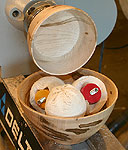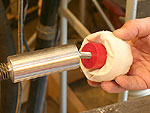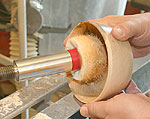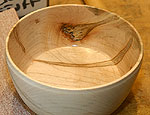This is a Veteran Owned site

 |
The 3-ball Beall Bowl Buff kit makes developing a smooth, consistent shine on the interior of bowls and other concave projects easy. Click image to enlarge |
Beall Bowl Buffs
The easy way to an inside shine
Text & photos by Tom Hintz
Posted – 8-12-2006
After using the Beall Buff System for a few months and growing accustomed to the deep, lustrous shine, getting the Beal Bowl Buffs to see if they worked as well on the inside surfaces moved to the top of my list. I am quickly learning that when Beall says something will work, you can take that to the bank.
The Kit
I have the 3”-diameter Beal Bowl Buffs set that comes with three individual buffs that used the same abrasive and wax sticks as the Beall Buff System. Beal Bowl Buffs in 2” and 4”-diameters are available also to handle a wide range of project size needs.
The Beal Bowl Buffs thread into the same combination ½” – 5/8” adaptor I use on my Beall Buff System. I attach that adaptor to the lathe with a Beall #2 Morse taper. This system makes converting the lathe for buffing fast and easy. Plus, changing between the buffing wheels or balls is equally quick.
The Beall Bowl Buffs
 |
The threaded stud makes installing and changing the balls between grits fast and tool free. Click image to enlarge |
Like the Beall Buff System the Beal Bowl Buffs kit has three different fabric balls, two designed for the two grits or the third for applying Carnauba wax. Each ball has a colored plastic collar at the threaded stud that makes identifying them easy.
The threaded stud requires hand power only for installing the balls on the adaptor. Whether used on a lathe (as I do) or on a grinder motor, changing the balls during polishing is fast and tool-free.
The first ball has a red plastic collar and is made from linen. This ball is loaded with tripoli compound, the most abrasive in the set and handles the initial smoothing chores.
The second ball has a white plastic collar and is made from a combination of linen and cotton flannel. Loaded with white diamond compound this ball both cleans away remaining Tripoli compound and does the final polishing.
The third ball has a yellow collar and is made from pure cotton flannel. This ball is used to apply a thin layer of Carnauba wax that both protects the surface and adds a final bit of shine to the piece.
Note: The 2”-diameter set has all three balls made from flannel.
In The Shop
 |
Learning to use the Beall Bowl Buffs is surprisingly simple. Getting used to not seeing what you are doing directly is the biggest part but an easy one to overcome. Click image to enlarge |
Using the Beal Bowl Buffs is simple and the instruction sheet that comes with the set describes the sequence and technique very well. If you have used the Beall Buff System, the Beal Bowl Buffs work the same way. The only difference is that where the 8”-diameter wheels of the Beall Buff System are limited to 1725 rpm, the Beal Bowl Buffs can be spun considerably faster because of their smaller diameter and mass. On my Delta 14” Iron Bed lathe (#46-715), I run the Beal Bowl Buffs at the highest speed setting (2600 rpm) and had no problems with vibration.
When new the Beal Bowl Buffs need a little break in time during which they tend to shed a bit. This is minimized by “trimming” them with a piece of 100-grit sandpaper wrapped around a scrap of wood and held against them before loading. Though a fabric buff will always shed a little, this process has no impact on the polishing.
The only trick to learning to use the Beal Bowl Buffs is getting the feel of working them inside of the bowl where you can’t directly see what is happening. I found that the easiest way to insure complete coverage was to establish a pattern that is repeated through all of the steps. There is a natural overlap due to the balls conforming to the surface being polished that makes achieving an even shine throughout the interior of a bowl easy.
While the rounded end of the Beal Bowl Buffs does a good job, it is turning slower than the rest of the ball. Changing angles during polishing exposes more of the surface to the faster-moving sides of the ball and speeds the process of refining the bottom area considerably.
The first bowl I polished with the Beal Bowl Buffs had a rather crisp transition from the bottom to the sides but the balls polished that area easily. The resulting shine was consistent throughout the interior of the bowl.
 |
Developing the same consistent shine inside a bowl as outside is surprisingly easy with the Beall Bowl Buffs. It really dresses up the project! Click image to enlarge |
I was a bit surprised to discover that the Beal Bowl Buffs work just as fast as the larger Beall Buff System wheels, or at least they seem to. Though I anticipated a slower process, the interior of my bowls shinned up much faster than I expected. Buffing the interior and outer surfaces of the bowl in the photos took less than 20 minutes.
As with any finishing process, the better the surface is sanded, the better the finish will be. I sanded the bowl in the photos (inside and out) down to 220-grit, which produced a surface that responded well to the Beal Bowl Buffs abrasives.
Conclusions
The Beal Bowl Buffs makes finishing concave or bowl interior surfaces easy and produces the consistent luster you thought only others could do. They are also easy to use and maintain. Unless you work on a production online, the Beal Bowl Buffs will last a very long time, making the $39.00 investment for the 3” or 4” sized, three buff systems ($34.00 for the 2” set) (8-`2-2006) a very small price to pay for the dazzling results achieved.
If you want to step up your finishing capabilities, a hard look at the Beal Bowl Buffs should be at the top of your list.
Have a comment on this review? –Email Me!
All written, photographic and drawn materials are property of and copyright by NewWoodworker.com LLC 2000-2019. Materials may not be used in any way without the written permission of the owner.
